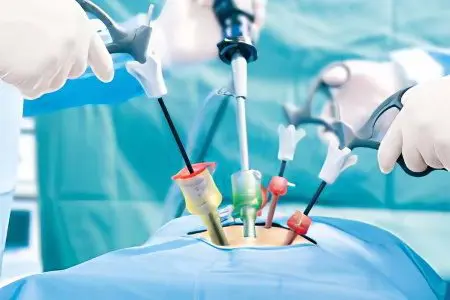Contents

The spread of the endometrium of the uterus beyond this organ can occur both in the reproductive system and in the intestines, in the bladder, in the pelvic peritoneum, in the lungs and even in the eyes. Endometrial cells in any part of the female body are subject to the cyclic action of female hormones and bleed during menstruation.
If there is no exit of blood from damaged vessels, it accumulates, forming cysts, nodes, plaques and other formations. This disease is very common among women of reproductive age who have gynecological problems. Among those patients who are treated for infertility and undergo a detailed examination (in particular, laparoscopy), up to 44% have a similar diagnosis.
Extragenital endometriosis, which includes damage to the peritoneum of the small pelvis, is from 6 to 8% of all recorded cases of the disease. Regardless of the localization, endometriosis is not a local, but a general disease that causes disturbances in the work of the endocrine and nervous system in a woman.
Etiology of the disease

The atypical distribution of endometrial cells is based on their movement through the blood and lymph flow to other organs and tissues.
This is facilitated by medical manipulations inside the uterus:
Diagnostic curettage;
Abortion;
C-section;
Manual examination of her cavity after childbirth.
Among other factors in the development of the disease, experts call injuries to the inner surface of the abdominal cavity, combined with reduced immunity. It can be inflammation, mechanical damage, surgery. In addition, genetic predisposition plays an important role.
There is an assumption that endometrial cells during menstruation, for some reason, are not excreted through the cervical canal, but are thrown into the abdominal cavity through the fallopian tubes. Normally, this situation is stopped by immune cells (macrophages), but if there are problems with the endocrine and immune systems, this protection may not work. Peritoneal cells (mesotheliocytes) begin to interact with endometrial cells, forming foci of the disease.
Clinical picture of peritoneal endometriosis

There are two forms of peritoneal endometriosis:
Heterotopia is diagnosed exclusively in the peritoneum of the small pelvis;
In addition to the peritoneum, endometriosis affects the uterus, ovaries, fallopian tubes, and intestines.
The severity of the disease depends on the following factors:
The area of foci of peritoneal endometriosis (from extensive to minimal);
The presence of adhesions, their severity (from single to complete obliteration);
The depth of the peritoneal lesion (1-3 cm).
A small form of the disease does not manifest itself for a long time, it proceeds latently.
With the spread of foci of the disease into the deeper layers of fiber before and after menstruation, the following symptoms appear:
Exhausting pain in the lower abdomen of a pulling or aching character;
Discomfort during sexual contact and during physical exertion;
Violation of the functioning of the abdominal organs – problems with urination, defecation, bending of the uterus due to adhesions in the peritoneum;
Absence of normal ovulation due to the adhesive process, and, as a result, infertility.
Diagnosis of peritoneal endometriosis
Most often, endometriosis of the abdominal cavity is detected during laparoscopy.
Morphological manifestations of peritoneal endometriosis:
Vesicles of a whitish hue without pigment;
Hemorrhagic vesicles – small cysts filled with thick tar-like contents;
Superficial and deep foci of the endometrium (heterotopia) of blue, purple, black;
Knots, tubercles, spots, painted in yellow-brown color.
Surgery

The only radical remedy that allows you to get rid of foci of endometriosis is laparoscopy.
This procedure has many positive properties:
She is less traumatic;
A woman does not lose the ability to bear children;
During laparoscopy, the doctor has the opportunity to objectively assess the condition of the internal organs;
The very next day, in the absence of complications, you can leave the hospital;
Traces of the operation heal quickly, they are 3 small punctures in the anterior wall of the peritoneum.
During laparoscopy, the doctor grabs the endometriosis focus with a clamp and cuts it off with special scissors. The defects of the peritoneum remaining after this heal quickly. To prevent the disease from spreading further, the tissues excised during laparoscopy are removed through the operating channel in a special container.
In addition to surgery, it is possible to carry out cryodestruction, laser coagulation, excision of nodes with an electric knife, argon coagulator, and an ultrasonic scalpel.
Conservative treatment

In addition to removing the foci of the disease, the goal of specialists involved in the treatment of endometriosis is:
Prevention of recurrence of the disease;
Protection against complications, consequences of adhesive disease;
Therapy of pain syndrome;
Treatment of posthemorrhagic anemia;
Relief of psychoneurological manifestations.
Hormone therapy lasts from 2 months to six months.
It includes the following groups of drugs:
Estrogen-gestagens – Microgynon, Diane-35, Ovidon, Rigevidon, Anovlar, a side effect is an increased risk of thrombosis;
Progestins that effectively relieve pain – Norkolut, Depostat, Duphaston, Orgametril, a side effect – weight gain, swelling of the limbs, tension in the mammary glands, breakthrough uterine bleeding;
Gonadotropin-releasing hormone agonists that cause temporary amenorrhea – Suprefect-depot, Zoladex, Decapeptyl-depot, side effect – hot flashes similar to menopausal syndrome;
Androgens – Testosterone, Sustanon-250;
Anabolic steroids – Retabolil, Methylandrostenediol;
Anti-estrogens – Tamoxifen, Toremifene.
These drugs require strict control of contraindications and side effects.
Other groups of drugs for symptomatic treatment:
Immunomodulators – Levamisole, Cycloferon, Timogen;
Antioxidants – ascorbic acid, vitamin E, pycnogenol;
NSAIDs for pain relief and treatment of inflammatory processes – Brufen, Indomethacin;
Antispasmodics – Analgin, No-shpa;
Tranquilizers to eliminate neurological manifestations – seduxen, Elenium, Phenazepam, Rudotel, Tazepam;
Iron preparations for the treatment of hemorrhagic anemia (Ferroplex, Fenyuls).
With the exact selection of drugs and the implementation of the doctor’s recommendations, peritoneal endometriosis is effectively treated.
Prognosis of the development of the disease
Relapses occur in 20% of women of reproductive age with a similar diagnosis. In premenopause, the prognosis is more favorable because the production of estrogen by the ovaries gradually decreases. After radical surgery, peritoneal endometriosis does not recur, the ability to bear children is restored.









